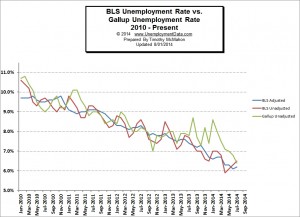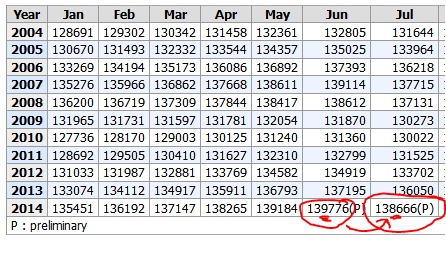The U.S. Bureau of Labor Statistics (BLS) released the July Unemployment figures on August 1st. The Seasonally Adjusted Unemployment Rate was 6.2% up from 6.1% in June. The Unadjusted Unemployment rate was also up from 6.3% in June to 6.5% July. Of course the spin-doctors at the BLS said it was “virtually unchanged”.

Of course, we shouldn’t get too excited because the “adjusted numbers” are still a bit on the low side and the smoke and mirrors coming out of the BLS have simply shifted to the Employment numbers.
Employment Numbers
According to the commissioner of the Bureau of Labor Statistics monthly report, “Total non-farm payroll employment increased by 209,000 in July, the same as its average monthly gain over the prior 12 months. In July, employment grew in professional and business services, manufacturing, retail trade, and construction.”
So we might begin to wonder if Employment went up, how did unemployment also go up? Of course, the commissioner downplayed that by saying it was “virtually unchanged”. But when we look at the Unadjusted employment number the 209,000 jobs mysteriously vanish and we are left with a steaming crater. Somehow, the unadjusted numbers show a loss of a whopping 1 MILLION 100 THOUSAND jobs!
Here is a screenshot from the BLS’ own data (data is in thousands):

Of course, since it seems to happen every year at this time they can “seasonally adjust it away” and say we gained jobs because we didn’t lose as much as an average year. But I would guess that the million people who lost their jobs might not look at it that way. And that doesn’t explain why the “Seasonally Adjusted” Unemployment rate still went up.
According to the BLS the U-6 unemployment rate for July was 12.6% up from 11.7% in May and 12.4% in June. But Gallup says that the situation is actually much worse than that and their equivalent of the U-6 rate is at 15.1% but it is down significantly from May when it was 16.4%. See BLS vs Gallup Numbers.
Payroll to Population Rate
The payroll to population rate looks at a slightly different metric than the unemployment rate although at first blush it sounds similar. While the unemployment rate looks at the percentage of the “workforce” that can’t find a job (and a fairly narrow definition of the term workforce at that). Gallup’s Payroll to Population rate (P2P) looks at the percentage of the total population that is working. This number, in my opinion, is much less subject to fudging since although you can redefine the term “workforce” as evidenced by the various unemployment rates (U1 through U-6) it is much more difficult to redefine the total population of the United States.
Unlike the unemployment rate where a lower number is better, in the P2P, a higher number is better in that it indicates a greater percentage of the population is working. In July, Gallup’s P2P was 45.1% up from June’s 45.0%.
See Also:
